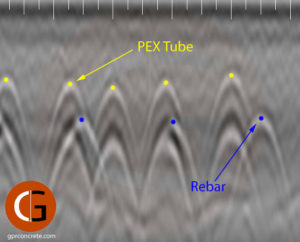This article is the first in a three part series about 2D and 3D ground penetrating radar methods. In this first article we take a detailed look at 2D GPR scanning. The second article will do the same with 3D GPR scanning. With the third, we will compare and contrast the two methods, and present a few case studies highlighting each.
2D GPR Overview

With 2D GPR scanning, or real-time line scanning, the GPR machine is used a bit like a sophisticated stud finder. The radar antenna is moved across the top of the area to be scanned, and data is immediately displayed on the interface screen. The technician interprets the on-screen data and identifies relevant signals, then rolls the antenna backward to find the actual location of those signals. Once the operator is confident about his or her interpretation, the findings are usually marked directly on the scanned surface. This is the most common type of GPR service, and is the only method offered by many providers.
2D GPR Strengths
Real-time scanning allows our experienced technicians to rapidly identify all objects in areas which aren’t very busy. For example, mid span on an 8″ post tension concrete deck reinforced with a single mat of rebar. Assuming the location is outside the column line for banded PT cables, things move fast. Our technician will quickly identify and differentiate the rebar from uniform / distributed tendons, as well as any conduit. We mark everything out on the surface, and subsequent work, like core drilling or anchor embedments, can proceed immediately.
This real-time method is also great for extremely busy areas, if you have the option to relocate. Consider our PT deck example again, and let’s say you need a 3″ vent inside the wall line. Nobody realizes it, but the layout puts it smack dab in the middle of a banded cable series. Our technician will immediately identify the post tension cables and understand the implications. We also have the practical experience to understand that in most cases, moving a vent isn’t a big problem. Trying to safely squeeze that vent between two bands would burn a lot of time — and your money. Instead, we can quickly move outside the banded series, identify a reasonable location, and submit it back to you for approval.
Real-time Linescanning Strengths:
- Quick and efficient for simple projects
- Subsequent work can proceed immediately
- Rapid relocation away from unusable areas
2D GPR Weaknesses

The efficiency of real-time scanning drops off sharply when there’s no choice but to work in busy areas, or locations with poor data clarity. Let’s go back to our PT deck, but this time you need a toilet. Plans put it right in the middle of a column line and the banded PT cables. There’s an electrical panel in the next room, and a couple smurf tubes are sweeping diagonally through the slab. With the vent example earlier, we quickly moved you a few feet away, completely out of the danger zone. However, the architecture simply won’t allow that here. With code restrictions on clearance, the most movement we can probably get is to nudge it over a couple inches. Tackling something like this with 2D scanning often slows way down, for a handful of reasons.
To start, the data is generally raw, with very limited real-time processing available even from cutting edge technology. That limits the operator’s ability to differentiate multiple discrete targets, especially if they’re at different elevations. This is compounded by the small display screens on many field units. They’re great when you’re working overhead all day, but not so much when you’re trying to make sense of a convoluted mess.
Adding to the complexity, with 2D scanning, there’s no digital association between different scans. The technician makes a single scan, studies it, makes another scan, studies it, rinse and repeat. All the while, the operator’s building a mental picture of what’s happening inside the slab. It’s a bit like putting together a 3D jigsaw puzzle, except you don’t know what the final picture is supposed to look like. As more targets are added to the scanning area, the mental demands scale quickly. This part of the job is absolutely reliant on the expertise and mental capacity of the technician. When we refer to the industry leading expertise of our crew, this is one of the specific areas where they excel. It is extremely challenging, and we are exceptionally good at it, but the point remains: It’s better to avoid it if possible, and solve the problem from another direction.
This part of the job is absolutely reliant on the expertise and mental capacity of the technician. When we refer to the industry leading expertise of our technicians, this is one of the specific areas where they excel.
The final drawbacks to real-time scanning revolve around due diligence and accountability. There’s no opportunity for peer review. All of the actual work and decision making happen immediately, in the field. There is no practical way to thoroughly document the reasoning behind the interpretations. Data can be logged to the GPR interface, but it only provides a retroactive snapshot, not a comprehensive review.
Real-time Linescanning Weaknesses:
- Time consuming for complex areas without tolerance for redesign
- Data is generally raw and unprocessed
- Can quickly exceed technician’s expertise
- Limited persistent data for written deliverable
- No opportunity for peer review
2D GPR Summary
There’s a saying, “I suppose it is tempting, if the only tool you have is a hammer, to treat everything as if it were a nail.” – Maslow
Real-time linescanning is an excellent and cost-efficient method of performing routine ground penetrating radar scanning. With adequate training, a technician can rapidly evaluate, confirm, and eliminate specific locations. It has significant limitations, however, which can easily be exceeded by data quality and complexity. Fully qualified expert technicians will recognize these conditions and present other solutions to overcome the challenges safely and efficiently.
